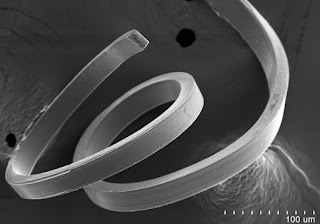Topics: Condensed Matter Physics, Nanotechnology, Materials Science, Metamaterials, Solid State Physics
Until recently, “flexible ferroelectrics” could have been thought of as the same type of oxymoronic phrase. However, thanks to a new discovery by the U.S. Department of Energy’s (DOE) Argonne National Laboratory in collaboration with researchers at Northwestern University, scientists have pioneered a new class of materials with advanced functionalities that moves the idea from the realm of irony into reality.
Ferroelectrics are a useful type of material that is found in capacitors that are used in sensors, as well as computer memory and RFID cards. Their special properties originate from the fact that they contain charged regions polarized in a specific orientation, which can be controlled with an external electric field. But they’ve also had a big drawback as engineers try to use them in new inventions.
“Ferroelectric materials are known for being quite brittle, and so it has always been a big challenge to make them mechanically flexible,” said Argonne nanoscientist Seungbum Hong, who helped to lead the research. “Because ferroelectricity and this kind of flexibility are relatively rare properties to see on their own, to have both ferroelectricity and flexibility in this new material is basically unprecedented.”
Argonne National Laboratory: Flexible ferroelectrics bring two material worlds together

Comments